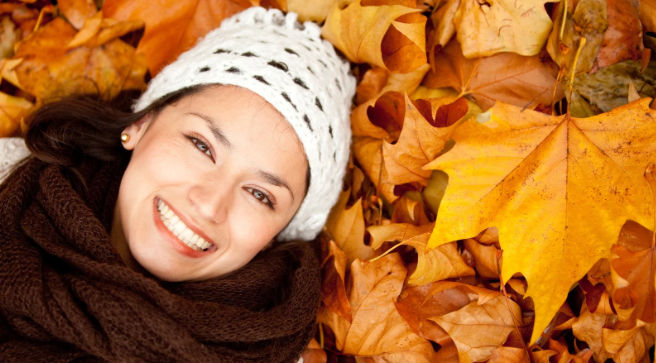Fall is the best-smelling season. Naturalists reveal why it's such a delight for the senses.
It's a perfect combination of organic and atmospheric reactions.
A family playing football in the fall leaves.
There’s one day in mid-September when the first hint of crisp air cuts its way through the summer heat, and it signals that the world around us is in a period of transition. For many, fall is their favorite time of year because it’s all about getting cozy, as well as enjoying the earthy smell of leaves on the ground and the sweet-and-spicy flavors we associate with autumn.
Why does the fall smell so sweet? And why does the outside air mesh so perfectly with the scent of turkey or a pumpkin-spiced latte?
Why does fall have such a great smell?
The sweet, earthly smell of fall is actually caused by decay and decomposition. The once-green leaves have turned an autumnal hue of orange, brown, and yellow, and are decomposing into the rain-soaked ground. As they decompose, the leaves' carbohydrates and sugars do, too, releasing a sweet smell into the air.

“That’s what fall is all about. Leaves are falling off the trees and the bacteria and fungi that are in the soil are actively digesting [them,]” Theresa Crimmins, director of the USA National Phenology Network, told PBS. “And in the process, various [gases] are being released, and that’s a lot of what the smells are.”
“The smell of fall represents a lot of decomposition as plants decay,” Pamela Dalton, a cognitive psychologist at the Monell Chemical Senses Center in Philadelphia, told WHYY. “As they change from when the leaves were green, and now they’re changing color, they’re also changing the kinds of odors that they give off. And that can be very evocative for us because it’s become associated with a period of time that is a somewhat pleasant transition for most people.”
Another reason why the fall smells so sweet is that the outside temperature makes it easier to identify specific scents. During the summer, heat and humidity trap many scents in the air, combining them so that many are indistinguishable. However, when things cool down, there are fewer volatile molecules in the air, allowing us to distinguish different scents, including those of decaying organic matter.

Aside from the scientific reasons why fall has a delicious smell, there is an emotional component as well. In our brains, scent and emotion are very closely connected. Fall has a very strong smell that can trigger emotional memories.
“This direct pathway allows smells to quickly evoke intense emotional responses and memories,” Valentina Parma, the assistant director of the Monell Chemical Senses Center in Philadelphia, told Self. “When a particular scent is present during an emotionally significant event, it can become strongly encoded in the hippocampus.
That’s why when the first whiff of fall hits your nose, you may immediately begin to well up with emotions, thinking about your homecoming dance, Halloween from years past, Thanksgiving, watching a football game in the chilly air, or your first day of middle school.
Ultimately, it's interesting that the intoxicating smell of fall—a sense that brings people much joy and nostalgia—is tied to death and decay. It’s a reminder that we are connected to every turn in the cycle of life and that, even in a period of decay, one can find joy.
